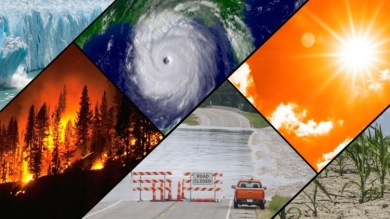Heading into 2024, most economists and market analysts have adopted a baseline scenario in which most major economies avoid both a recession and renewed inflation – the much-desired "soft landing." But the current encouraging consensus could still be derailed by any number of factors, not least geopolitics.

NEW YORK – Around this time a year ago, about 85% of economists and market analysts – including me – expected that the US and global economy would suffer a recession. Falling but still-sticky inflation suggested that monetary policy would grow tighter before rapidly easing once the recession hit; stock markets would fall, and bond yields would remain high.
Instead, the opposite mostly happened. Inflation fell more than expected, a recession was avoided, stock markets rose, and bond yields fell after going higher.
One therefore must approach any 2024 forecast with humility. Still, the basic task is the same: start with a baseline, an upside, and a downside scenario, and then assign time-varying probabilities to each.
The current baseline for many, though not all, economists and analysts is a soft landing: advanced economies – starting with the United States – avoid a recession, but growth is below potential and inflation continues to fall toward the 2% target by 2025, while central banks may start to cut policy rates in the first or second quarter of this year. This scenario would be the best one for equity and bond markets, which have already started to rally in expectation of it.
An upside scenario is one with “no landing”: growth – at least in the US – remains above potential, and inflation falls less than markets and the US Federal Reserve anticipate. Rate cuts would occur later and at a slower pace than what the Fed, other central banks, and markets are currently expecting. Paradoxically, a no-landing scenario would be bad for stock and bond markets despite surprisingly stronger growth, because it implies that interest rates will remain somewhat higher for longer.
A modest downside scenario is a bumpy landing with a short, shallow recession that pushes inflation lower, faster than central banks expect. Lower policy rates would come sooner, and rather than the three 25-basis-point cuts that the Fed has signaled, there could be the six that markets are currently pricing in.
Of course, there could also be a more severe recession, leading to a credit and debt crisis. But while this scenario looked quite probable last year – owing to the commodity-price spike following Russia’s invasion of Ukraine and some bank failures in the US and Europe – it seems unlikely today, given the weakness of aggregate demand. It would become a concern only if there were a new large stagflationary shock, such as a spike in energy prices stemming from the conflict in Gaza, especially if it escalates into a wider regional war involving Hezbollah and Iran that disrupts oil production and exports from the Gulf.
Other geopolitical shocks, like new tensions between the US and China, would probably be less stagflationary (lower growth and higher inflation) than contractionary (lower growth and lower inflation), unless trade is massively disrupted, or Taiwanese chip production and exports are impaired. Another major shock could come in November with the US presidential election. But that will bear more on the 2025 outlook, unless there is major domestic instability ahead of the vote. Again, though, US political turmoil would contribute to stagnation rather than stagflation.
With respect to the global economy, both a no-landing scenario and a hard-landing scenario currently look like low-probability tail risks, even if the probability of no landing is higher for the US than for other advanced economies. Whether there is a soft landing or a bumpy landing then depends on the country or region.
For example, the US and some other advanced economies look like they may well achieve a soft landing. Despite tighter monetary policy, growth in 2023 was above potential, and inflation still fell as the pandemic-era negative aggregate supply shocks subsided. By contrast, the eurozone and the United Kingdom had below-potential growth close to zero or negative for the last few quarters as inflation fell and may miss out on stronger performance in 2024 if the factors contributing to weak growth persist.
Whether most advanced economies will have a soft or bumpy landing depends on several factors. For starters, monetary-policy tightening, which operates on a lag, could have a greater impact in 2024 than it did in 2023. Moreover, debt refinancing could saddle many firms and households with substantially higher debt servicing costs this year and next. And if some geopolitical shock triggers another bout of inflation, central banks will be forced to postpone rate cuts. It would not take much escalation of the conflict in the Middle East to drive up energy prices and force central banks to reconsider their current outlook. And many stagflationary megathreats over the medium-term horizon could push growth lower and inflation higher.
Then there is China, which is already experiencing a bumpy landing. Without structural reforms (which do not appear forthcoming), its growth potential will be below 4% in the next three years, falling closer to 3% by 2030. Chinese authorities may consider it unacceptable to have actual growth below 4% this year; but a growth rate of 5% simply is not achievable without a massive macro stimulus, which would increase already high leverage ratios to dangerous levels.
China will most likely implement a moderate stimulus that is sufficient to get growth slightly above 4% in 2024. Meanwhile, the structural drags on growth – societal aging, a debt and real-estate overhang, state meddling in the economy, the lack of a strong social safety net – will persist. Ultimately, China may avoid a full-scale hard landing with a severe debt and financial crisis; but it likely looks like a bumpy landing ahead, with disappointing growth.
The best scenario for asset prices, stocks, and bonds is a soft landing, though this may now partly be priced in. A no-landing scenario is good for the real economy but bad for equity and bond markets, because it will prevent central banks from following through with rate cuts. A bumpy landing would be bad for stocks – at least until the short, shallow recession looks like it has bottomed out – and good for bond prices, since it implies rate cuts sooner and faster. Finally, a more severe stagflationary scenario is obviously the worst for both stocks and bond yields.
For now, the worst-case scenarios appear to be the least likely. But any number of factors, not least geopolitical developments, could be this year’s forecast spoiler.
NOURIEL ROUBINI - From Project-Syndicate









